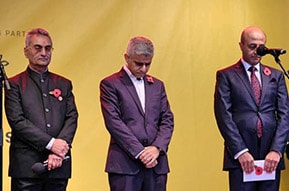A Case Study of Religious Harmony and Dialogue
A Case Study of Religious Harmony and Dialogue
Among many examples of positive progress towards religious harmony and mutual respect is BAPS – a socio-spiritual organisation which has led the effort to bring about dialogue between different faiths and promote the values of unity in diversity.

At the inaugural R20 gathering in Bali in November 2022, Sadhu Bhadreshdas of BAPS engaged in dialogue with leaders of the Muslim community on ‘Spiritual Ecology’. Sanatan Dharma has never viewed nature as something outside of ‘religion’ whereby nature is a mere resource. Nature has always been at the heart of dharma’s approach – from diet and puja rituals to the belief in transmigration, one sees how nature is infused in everyday practice. Cosmic balance is as much internal as it is external. India will lead the G20 for the next year, announcing its vision of One Earth, One Family, One Future. The R20 dialogue between Hindu and Muslim leaders on the issue of ecology and the environment is a major step in the right direction. There is no greater opportunity to demonstrate the relevance of faith than faith in action in an attempt to save the most sacred thing: creation itself.
One might think of interfaith dialogue as a recent phenomenon, but Bhagwan Swaminarayan had already demonstrated it in practice 200 years ago when in dialogue with British officials in Gujarat. Traditionally, certainly prior to the era of Swami Vivekananda who proclaimed a glorious ideal of plurality through Advaita Vedanta in 1893, dialogue typically happened between monotheistic faiths. Traditions seen as pagan or polytheistic, did not have the capacity for dialogue. This soon began to change as European and North American thinkers studied the Upanishads, Bhagavad Gita and Vedas and realised that dialogue was not about merely tolerating or trying to win over other faiths. Dialogue is fundamentally about how all traditions can unite in tackling the crisis facing human civilisation. It allows for all traditions to be given an equal platform in contributing towards a shared set of values.
Bhagwan Swaminarayan also shared the key codes of conduct and principles of ekantik dharma, which was the purpose of his manifestation, with officers such as Governor John Malcolm when they met in Rajkot in 1830. Most importantly, Bhagwan Swaminarayan did not become influenced by Anglicised notions of religion unlike some of his contemporaries. The depth of knowledge he possessed meant he approached dialogue confidently yet humbly. Sometimes, those who engage in dialogue themselves struggle to foster greater inclusivity in their own faith circles. Bhagwan Swaminarayan’s teachings inspired not only educated sadhus and royal bards but tribal people and warrior clans – he sought to transform people into better human beings.
Pramukh Swami Maharaj utilised the same approach in a global context. He travelled across the world and met leaders and members of all faith communities. However, this was not with a missionary zeal, but with the singular message: be a better adherent of your own faith rather than trying to seek more converts. The world needed a citizenry which realised that the essence of their own faith was to be a better human being, period. This is what Pramukh Swami Maharaj inspired.
2002. Gandhinagar. The Swaminarayan Akshardham Mandir was victim to a terrorist attack, killing 33 people. Pramukh Swami Maharaj’s response was practical: the authorities do their job, and we, as members of faith, do our job: pray to God, strive for harmony, and let actions speak louder than words. He realised his actions were not just consequential for Hindus but for all religious communities in India.
Leaders in the UAE have generously gifted land to build a Hindu mandir in Abu Dhabi, and BAPS is working to fulfil that mission and yet again strengthen the bridges between religious communities. This shows a proactive approach to genuinely creating a space for different faiths to co-exist and become an integral part of the architectural landscape. This took many decades to achieve even in the Western world.
For centuries, ‘I alone have the Truth’ has caused conflict, destruction and now risks ecological meltdown and renewed warfare. Is dharmic dialogue the only hope for harmony? Can BAPS’ ‘better human beings’ approach be applied to the creation of a better world for all? Indeed, that would be a wonderful world to live in









































